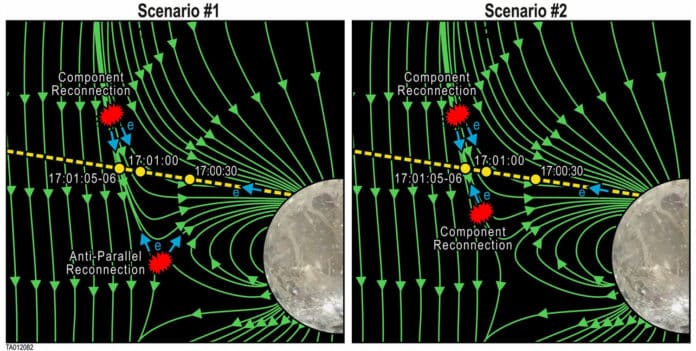Ganymede, Jupiter’s largest moon, is the only moon in our solar system with its magnetic field. Its intrinsic magnetic field permeates into the surrounding space environment creating a magnetosphere embedded within the magnetic field and sub-Alfvénic plasma flow of Jupiter’s magnetosphere.
NASA’s Juno spacecraft made a close flyby of Ganymede and flew through its magnetosphere on 7 June 2021, including an outbound crossing of Ganymede’s upstream magnetopause. During this flyby, the spacecraft observed evidence of magnetic reconnection.
A team led by Southwest Research Institute used Juno data to examine the electron and ion particles and magnetic fields as the magnetic field lines of Jupiter and Ganymede merged, snapped, and reoriented heating and accelerating the charged particles in the region.
Magnetic reconnection is a fundamental plasma physics process whereby magnetic field lines can merge and reorient. Additionally, this process transforms magnetic energy that has been stored, which can heat and accelerate local ions and electrons.
Dr. Robert Ebert, lead author of a Geophysical Research Letters paper describing the findings, said, “We interpreted the presence of accelerated electrons traveling along the magnetic field at Ganymede’s magnetopause as evidence that magnetic reconnection was occurring there during the Juno flyby. These observations further support the notion that magnetic reconnection at Ganymede’s magnetopause can be a driver of dynamic processes in the local space environment around this moon of Jupiter.”
On board Juno, the SwRI-designed Jovian Auroral Distributions Experiment (JADE) saw increased electron fluxes, including accelerated, magnetic field-aligned electrons. It is believed that the reconnection that Juno saw was connected to the generation of Ganymede’s aurora.
Dr. Stephen Fuselier, a co-author of the paper, said, “The accelerated electrons observed by JADE are similar to those observed by NASA’s Magnetospheric Multiscale (MSS) spacecraft during reconnection at the Earth’s magnetopause. That’s one of the exciting results from the Ganymede flyby: Despite the vast differences between Ganymede and Earth, we find commonality in the universal process of magnetic reconnection.”
Thomas Greathouse, a Juno scientist from SwRI, said, “Nothing is simple — or small — when you have the biggest planet in the solar system as your neighbor. This was the first measurement of this complicated interaction at Ganymede. This gives us a very early tantalizing taste of the information we expect to learn from ESA’s JUICE mission.”
Journal Reference:
- R. W. Ebert et al. Evidence for Magnetic Reconnection at Ganymede’s Upstream Magnetopause During the PJ34 Juno Flyby. Geophysical Research Letters. DOI. 10.1029/2022GL099775
